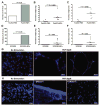Tissue factor expressed by circulating cancer cell-derived microparticles drastically increases the incidence of deep vein thrombosis in mice
- PMID: 25955268
- PMCID: PMC4496280
- DOI: 10.1111/jth.13002
Tissue factor expressed by circulating cancer cell-derived microparticles drastically increases the incidence of deep vein thrombosis in mice
Abstract
Background: The risk of thrombotic complications such as deep vein thrombosis (DVT) during tumor development is well known. Tumors release into the circulation procoagulant microparticles (MPs) that can participate in thrombus formation following vessel injury. The importance of this MP tissue factor (TF) in the initiation of cancer-associated DVT remains uncertain.
Objective: To investigate how pancreatic cancer MPs promote DVT in vivo.
Methods: We combined a DVT mouse model in which thrombosis is induced by flow restriction in the inferior vena cava with one of subcutaneous pancreatic cancer in C57BL/6J mice. We infused high-TF and low-TF tumor MPs to determine the importance of TF in experimental cancer-associated DVT.
Results: Both tumor-bearing mice and mice infused with tumor MPs subjected to 3 h of partial flow restriction developed an occlusive thrombus; fewer than one-third of the control mice did. We observed that MPs adhered to neutrophil extracellular traps (NETs), which are functionally important players during DVT, whereas neither P-selectin nor glycoprotein Ib were required for MP recruitment in DVT. The thrombotic phenotype induced by MP infusion was suppressed by hirudin, suggesting the importance of thrombin generation. TF carried by tumor MPs was essential to promote DVT, as mice infused with low-TF tumor MPs had less thrombosis than mice infused with high-TF tumor MPs.
Conclusions: TF expressed on tumor MPs contributes to the increased incidence of cancer-associated venous thrombosis in mice in vivo. These MPs may adhere to NETs formed at the site of thrombosis.
Keywords: cancer; cell-derived microparticles; neutrophils; tissue factor; venous thrombosis.
© 2015 International Society on Thrombosis and Haemostasis.
Conflict of interest statement
G. M. Thomas and D. D. Wagner report grants from National Institutes of Health, NHLBI, during the conduct of the study.
Other authors state that they have no conflict of interests.
Figures



Comment in
-
Tissue factor expressed by circulating cancer cell-derived microparticles drastically increases the incidence of deep vein thrombosis in mice: comment.J Thromb Haemost. 2015 Sep;13(9):1737-8. doi: 10.1111/jth.13050. Epub 2015 Jul 28. J Thromb Haemost. 2015. PMID: 26179190 No abstract available.
References
-
- Silverstein MD, Heit JA, Mohr DN, Petterson TM, O’Fallon WM, Melton LJ., 3rd Trends in the incidence of deep vein thrombosis and pulmonary embolism: a 25-year population-based study. Arch Intern Med. 1998;158:585–93. - PubMed
-
- Heit JA, Silverstein MD, Mohr DN, Petterson TM, O’Fallon WM, Melton LJ., 3rd Risk factors for deep vein thrombosis and pulmonary embolism: a population-based case-control study. Arch Intern Med. 2000;160:809–15. - PubMed
-
- Blom JW, Doggen CJM, Osanto S, Rosendaal FR. Malignancies, prothrombotic mutations, and the risk of venous thrombosis. JAMA. 2005;293:715–22. - PubMed
-
- Prandoni P, Lensing AWA, Piccioli A, Bernardi E, Simioni P, Girolami B, Marchiori A, Sabbion P, Prins MH, Noventa F, Girolami A. Recurrent venous thromboembolism and bleeding complications during anticoagulant treatment in patients with cancer and venous thrombosis. Blood. 2002;100:3484–8. - PubMed
-
- Stein PD, Beemath A, Meyers FA, Skaf E, Sanchez J, Olson RE. Incidence of venous thromboembolism in patients hospitalized with cancer. Am J Med. 2006;119:60–8. - PubMed
Publication types
MeSH terms
Substances
Grants and funding
LinkOut - more resources
Full Text Sources
Other Literature Sources
Medical
Miscellaneous

